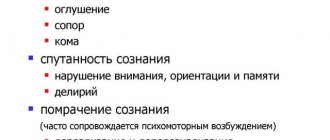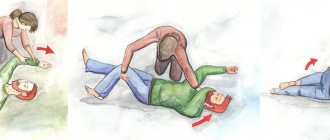Twilight disorder is a sudden and short-term loss of clarity of consciousness.
During this period, a person completely detaches himself from everything that surrounds him, or perceives the world distortedly. In the twilight state, habitual automatic actions are preserved, but delusions and hallucinations may appear, causing fear, melancholy, aggressive behavior, and rage. The attack passes as unexpectedly as it began. The individual has no memories of him, but sometimes they are fragmentary.
The twilight state of consciousness can last several minutes, days, and sometimes longer. It necessarily requires serious treatment by psychiatrists, since it poses a danger to both the person suffering from it and the people around him. Therefore, in the event of an attack, immediate hospitalization is necessary.
Causes and types
The causes of pathology are divided into two groups:
- organic - epilepsy, epileptiform syndrome, brain diseases, including tumors, damage to the medial temporal regions as a result of traumatic brain injury and a number of other conditions;
- functional - hysterical psychoses and narrowing of consciousness, affective states, unexpected situations with consequences in the form of severe psychological trauma.
There are twilight psychotic and non-psychotic disorders. The first include the following types, which have characteristic manifestations:
- Dysphoric twilight state of consciousness. A person acts in an orderly manner, he is self-absorbed, detached from the outside world, sad, does not respond to someone addressing him, or utters some stereotypical words that are not related to what the interlocutor is saying. The face is gloomy, even angry. Such patients can recognize familiar people and situations, but act inappropriately and are unable to critically evaluate what they are doing. Fleeting sensations of having a double, birth and death, etc. may arise.
- Delusional twilight disorder of consciousness. Delusional ideas are formed, and the patient’s behavior corresponds to their content. It seems to him that someone is pursuing him, wants to harm him, make him suffer, kill him. He is focused, behaves in an orderly manner, but normal communication with him is impossible. The patient’s actions are aimed at protecting against an imaginary threat dictated by delusion, most often antisocial. When the condition returns to normal, memories of the experience remain.
- Hallucinatory disorder is characterized by the presence of illusions and frightening visual and auditory hallucinations. Communication is impossible, since such a patient does not perceive reality and the appeal to him at all. He hums, pronounces or shouts individual words or phrases, most often inarticulate. As a reaction to terrible visions, aggression arises, the outbreaks of which result in very harsh actions performed with enormous force - beating, killing with bare hands or with the help of sharp objects.
A number of psychiatrists identify another type of psychotic twilight state of consciousness - oneiric. It is characterized by colorful fantastic or fairy-tale hallucinations, accompanied by catatonia - impaired motor functions, i.e. excitement or stupor.
Non-psychotic cloudings of consciousness include:
- Somniloquy - talking in your sleep.
- Somnambulism - sleepwalking, sleepwalking. Occurs in children and adolescents.
- Trances are long-term automatic actions. Most often, the patient leaves for another city.
- Outpatient automatisms are brief automatic actions. For example: a person leaves home, gets on public transport, and, upon waking up, finds himself incomprehensibly how and why in an unfamiliar place. The patient looks confused, thoughtful, there are no hallucinations or delusions. He does not remember at all what happened to him in a state of darkness.
- Genser's syndrome is a hysterical variant that occurs as a result of prolonged stress. The impetus for the development of the disorder is some kind of traumatic event, an unexpected exposure to unsafe, unusual conditions. The patient can only talk about these events, but he is not alienated from the world. The individual behaves like a clown, “falls into childhood” - he lisps, grimaces, and obviously answers simple questions absurdly. Knowing the purpose of things, he distorts their use, for example, he tries to pull gloves on his feet. Emotions suddenly change to the opposite. After an attack, the patient has fragmentary memories of what happened, which are restored after a good sleep.
The twilight state takes a person from reality to hallucinations. The latter replace a situation that was traumatic for him. Examples of darkness: amok - excitement, aggression and murder; the ritual of shamans - they introduce themselves into darkness and “infect” the participants in the action with it. An example can be given from literature - Lady Macbeth, the heroine of Shakespeare's tragedy of the same name, experiences a twilight episode in her sleep.
Back Next
Twilight stupefaction is characterized by:
• Sudden emergence and completion.
• Impaired perception of the environment: from fragmentary perception to complete detachment and disorientation.
• Motor sphere: from externally ordered automated behavior to pronounced arousal.
• Options:
- Outpatient automatisms - during clouding of consciousness, a person performs automated actions, behavior may outwardly look correct, the facial expression is detached and gloomy, statements are stereotypical or absent. If accompanied by involuntary wandering: while awake - fugue (several minutes) or trance (longer time, including leaving home, traveling); during sleep - somnambulism (sleepwalking).
- Hallucinatory-delusional twilight stupefaction - the patient is not available for productive contact, but from his behavior it can be assumed that during stupefaction he experiences various types of hallucinations (visual, auditory, including imperative, olfactory, etc.), along with which secondary sensory delusions (persecution, grandeur) are formed. Additionally, there are affective disorders - severe fear, anxiety, anger, enthusiasm, ecstasy. Sometimes they can be accompanied by pronounced agitation with aggression and destructive actions. Fortunately, such conditions are relatively rare and are usually the subject of forensic psychiatric examination.
• After emerging from stupefaction - complete amnesia (for real events and one’s own experiences), often after emerging - weakness, craving for sleep, so they fall asleep in inappropriate places.
• Duration - in most cases from several minutes (usually) to several hours (less often).
Separately designate variants of twilight stupefaction that arose under conditions that force them to be differentiated from “physiological” conditions (usually these cases are associated with the commission of offenses and subsequent forensic psychiatric examination):
- Pathological intoxication is a twilight stupefaction that developed against the background of drinking a small amount of alcohol (alcohol was only a trigger for the condition; there was no actual intoxication). Differentiate with a state of ordinary intoxication.
- Pathological affect is a twilight clouding of consciousness that developed in response to a psychotraumatic event (psychotrauma, usually minor, can only become a trigger for the development of clouding of consciousness). Differentiate with physiological affect (strong emotional excitement).
It is believed that a twilight state of consciousness can develop in patients with epilepsy (as the equivalent of epileptic paroxysm or as a variant of non-convulsive status epilepticus), organic brain damage. In world psychiatry, this type of stupefaction is currently rarely described.
Back Next
To see comments you must register
General symptoms
In a state of twilight disorder of consciousness, whatever type it may be, contact with the patient is impossible, since he is detached from the real world, does not perceive it partially or completely. His consciousness suddenly seems to turn off. He is disoriented to varying degrees in the situation, time, people, place. His thinking process is disrupted, his judgments are incoherent or completely absent.
It is difficult to distinguish a sick person from a healthy person by appearance, since he behaves quite normally and is capable of performing quite complex actions. However, as soon as you begin to communicate with him, it immediately becomes clear that the individual cannot say either his own name, the names of loved ones, or the date where exactly they are. Although his speech may be correct from a grammatical point of view, he cannot carry on a conversation, he talks to himself, does not answer questions and does not expect an answer to his own.
The behavior is usually aggressive and poses a danger to others.
After emerging from such a state, the patient remembers poorly or does not remember at all what happened to him and what he did.
Urgent Care
The danger of twilight disorder of consciousness is that the patient, under the influence of hallucinations, anxiety, and anger, can cause quite serious harm to himself and others, since extreme strength and aggression awakens in him. He can attack anyone nearby, destroy furniture, etc.
To avoid accidents and other negative consequences, you need to react to this condition very quickly. Of course, it is necessary to call an ambulance, but before the arrival of a specialized team, to ensure the safety of the patient, the patient should be persuaded to sit or lie down on the bed and not be left alone for a minute. It is necessary to ensure that there are no breakable or piercing objects, flammable or other dangerous substances nearby. You should not let him near windows, balconies, or doors.
For safe transportation of the patient, he is fixed and 2-4 ml of sibazon solution (0.5%) or Relanium, Seduxen, diazipam is administered intravenously. This is usually enough to calm him down. If the drug does not work, after 10 minutes you will have to administer half the dose of the same medicine. Neuroleptics with suprastin or diphenhydramine, as well as chlorpromazine, have a similar effect, but it lowers blood pressure, so it is not suitable for everyone.
A gloomy state can be a manifestation of epileptic seizures, then the gloom can be one-time or repeated. If a diagnosis of epilepsy is made and medications are prescribed, then the attack can be stopped with the prescribed medications. If psychomotor agitation does not go away, but increases, then mandatory hospitalization is required.
Diagnostics
Making a diagnosis for confusion is aimed at establishing the cause that caused it. The difficulty is that the patient, as a rule, is not able to provide a medical history. A general and biochemical examination of the patient’s blood and urine makes it possible to determine the presence of acute infection or intoxication. MRI is indicated to detect organic changes in the structure of the brain and circulatory disorders of its tissues. An EEG may show changes consistent with epilepsy.
Treatment
The diagnosis of “twilight disorder of consciousness” is made by a psychiatrist, studying the clinical picture and based on a conversation with the patient and his relatives. You will also need a consultation with a neurologist and a number of specialized specialists, as well as studies such as MRI and CT of the brain, EEG, etc.
If during the process of darkening the patient committed a crime: caused damage to property, harm to health or murder, then a forensic psychiatric examination is carried out. It, among other things, involves the study of documents compiled by law enforcement officers, forensic reports, and witness statements.
Treatment is carried out in the psychiatric department of the hospital with the help of antipsychotics and tranquilizers. The psychotic type of disorder will require individual psychotherapy. It is necessary in the event of a crime committed by a patient.
If the twilight state is of a non-psychotic type, then the underlying disease is treated.
Naturally, individual treatment tactics are selected for each patient, depending on the above factors.









